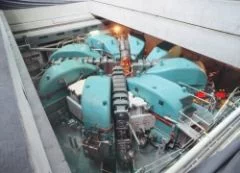SINQ is situated at the end of a cascade of three accelerators that deliver a proton beam of 590 MeV in energy at a current up to 2.3 mA. The situation of accelerator facilities, proton beam line and experiments is shown in the floor plan. The proton beam is pre-accelerated in a Cockcroft-Walton column to an energy of 870 keV and is brought up to an energy of 72 MeV in the 4-sector injector cyclotron. Final acceleration to 590 MeV occurs in the 8-sector mainring cyclotron, from which the beam is transported through the experimental hall in a shielded tunnel. A small fraction of the beam (20 µA) is split off by a splitter early to serve a proton irradiation and cancer therapy test facility. (It is intended to provide a separate accelerator for the cancer therapy facility in the near future and thus take off some operational restrictions on the main accelerator system that result from this additional use.)
The main beam passes through two pion production targets (M and E), whereby the proton energy is reduced to 570 MeV. After passing through the Targets the beam can either be dumped in a beam stopper or can be recaptured and bent downwards through a sloping drift tube for onward transport to SINQ-facility adjacent to the experimental hall.
Target E, presently a 6 cm long graphite target, is reduced in length to 4 cm, which will allow to recapture 70% of the beam (1.3 mA). The beam power available for SINQ will thus be roughly 0.75 MW. After passing through the pion production target (TE), the remaining proton beam is deflected by bending magnets downwards through a sloping drift tube into the basement of the SINQ-facility. The following picture of the SINQ-facility shows the SINQ-target station with its steel bulk shielding in the lower part and removable concrete shielding on top. Around the target station four of its eight sectors of experimental area are visible .

